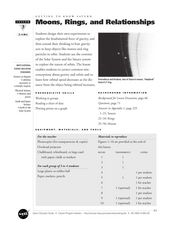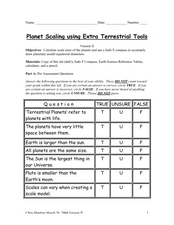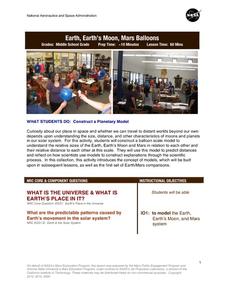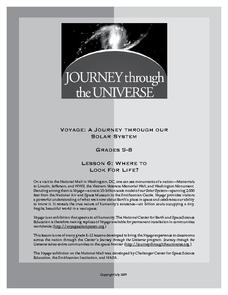Curated OER
Astronomy and Me: Moons Over New Haven
Third graders study the features of different moons orbiting the planets. In this astronomy lesson, 3rd graders explore the different phases of the moon using an interactive online website. They compare and contrast the features of the...
Curated OER
Living On The Moon
Students evaluate what life would be like living on the moon or another planet in our solar system. For this science lesson, students create a colony that they would use to live in on the moon using Legos.
Curated OER
Getting to Know Saturn: Moons, Rings, and Relationships
Students identify the different objects that orbit Saturn. For this space science lesson, students plot the graph of orbital speed and distance. They explain why planets and asteroids remain in orbit around the sun.
Curated OER
Phase to Phase with the Moon
Fourth graders study the Moon phases. The lesson includes hands-on activities as well as web-based activities. They use models of the Moon and a lamp to study each of the phases of the Moon, and test their knowlege of the Moon on a web...
Curated OER
Sun and Moon Folktale
Students become familiar with characteristics of folktales by reading or listening to African folktale that explains why sun and moon live in the sky. Students then create their own folktales about the sun and moon or another aspect of...
Curated OER
From Asteroids to Planets
In this asteroids and planets learning exercise, students read about the formation of planets from asteroids. Students solve 6 mathematical problems including finding the rate of growth of a planet, determining the mass of a planet at a...
Curated OER
Planets in the Solar System
Explore the planets with your young Spanish speakers. First, read Los Planetas by Chris Jaeggi. Then create a class solar system using different size balls as planets. They'll love helping you put it together!
New York Science Teacher
Planet Scaling using Extra Terrestrial Tools
Your class will use a set scale to convert diameters of planets to the model size, the diagram given to expand on the number of planets drawn as concentric circles, and examine the scale that would be needed to fit the larger...
Curated OER
Please Ex-Planet!
What is most useful about this lesson plan is the "Student Explanet Worksheet," a set of instructions for collaborative groups to use to collect information about an assigned planet. After students have researched and organized their...
Curated OER
Phases of the Moon
Students read "The Moon Seems to Change" and conduct an experiment with oranges to demonstrate the phases of the moon. They write about the experiment and describe each phase of the moon.
Education World
Every Day Edit - Pluto, the Dwarf Planet
In this everyday editing worksheet, students correct grammatical mistakes in a short paragraph about the planet Pluto. The errors range from punctuation, capitalization, spelling, and grammar.
University of Colorado
Clay Planets
Why do scientists use models? In the first installment of 22, groups create scale models of our solar system. They then share and discuss their models.
K12 Reader
Planets
Readers are asked to identify the main ideas and supporting ideas in a passage about the eight planets in our solar system.
Curated OER
The Moon
In this space science activity, students complete each of the statements with the correct word or phrase about the moon. Then they identify four ways that scientists believe the moon was formed, selecting one and writing a paragraph...
NASA
Earth, Earth’s Moon, Mars Balloons
Very specific diameters are given for blowing up three different balloons to represent, in scale, the moon, Earth, and Mars. In groups of three, amateur astronomers explore scale measurements and distance in space.
Curated OER
Making Regolith
You may not be able to take a field trip to the moon, but that doesn't mean your class can't study moon rocks. Using graham crackers as the moon's bedrock and powdered donuts as micrometeorites, young scientists simulate...
Journey Through the Universe
Where to Look For Life?
Every year we discover new planets including more than 1,000 in 2016 alone. Will we ever find life on another planet? The activity includes two activities to help scholars understand this concept. First, they analyze the temperature...
Curated OER
Regents High School Examination: Physical Setting Earth Science 2008
Throughout this earth science exam, high-school geologists complete a series of multiple choice and short answer questions about the solar system, atmosphere, and earth system. This is an amazing test, as are all of the exams developed...
Curated OER
Who Wants to be a Millionaire: Solar System
Fourth and fifth graders will love showing what they know about the planets and our solar system. This game is fashioned after "Who Wants to be a Millionaire" and has the class work through fifteen different solar system related...
Curated OER
Tour of the Solar System
Learners engage in science, math, and language activities as they do research on the components of the solar system. The class begins with some anticipatory activities and discussions before it is divided into small groups to conduct...
Vosonos
Interactive Minds: Solar System
Travel through space as you learn about the galaxy, solar system, planets, and much more. An extensive resource for studying astronomy in upper-elementary and middle school classrooms.
Curated OER
WebQuest Solar System Colonization Project 2000
Sixth graders investigate the livability of different planets in the universe by researching and organizing information from a number of sources in this unit project. They decide on a location for a space station which they support in an...
Curated OER
Sizing Up The Solar System
Students investigate and design various models of size and distance related to the solar system. They work together to build a solar system model. The models should focus on distance and scale. They don't include moons or satellites in...
Curated OER
What is the Solar System?
In this solar system worksheet, students will use a Venn Diagram to write about the characteristics that are unique to a moon and to a planet and then the characteristics that are the same for both a moon and planet.


